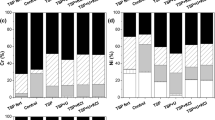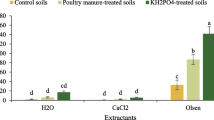Abstract
The effects of six phosphate (P) fertilizers in mobilizing and immobilizing water-soluble lead (Pb) were determined in a contaminated soil (Alfisol from Shaoxing) from China and four Australian soils (an Oxisol from Twonsville Queensland and three South Australian soils from Cooke Plains (Typic Palexeralf)), Inman Valley (Vertisol), and Two Wells (Natric Palexeralf). The fertilizers tested were single superphosphate (SSP), triple superphosphate (TSP), monoammonium phosphate (MAP), diammonium phosphate (DAP), monocalcium phosphate (MCP), and dicalcium phosphate (DCP) to produce an initial P concentration of 1,000 mg/L. The Chinese soil contained 16,397 mg/kg total Pb, but the Australian soils were uncontaminated. The four Australian soils were each spiked with 1,000 mg Pb/kg soil (as Pb(NO3)2) and incubated for a month. Single superphosphate treatments decreased total soluble Pb in soil solution to 2–14 % of those of the nil-P (0P) treatment in the four Pb-spiked soils and to 48 % in the Chinese Pb-contaminated soil. The DAP treatment followed by the MAP treatment greatly increased the total soluble Pb in soil solution up to 135–500 % of the 0P treatment, except in the Two Wells soil. MCP could decrease the total soluble Pb in Cooke Plains, Inman Valley, Shaoxing, and Two Wells soils while increase it in the Queensland soil; DCP decreased the total soluble Pb in Cooke Plains and Queensland soils while increased it in the Shaoxing and Inman Valley soils. There were close relationships between the total soluble Pb, total soluble Al, and total soluble Fe in the water extracts of each. Soluble Al and Fe ions in soil solution increased soluble Pb concentrations. We conclude that not all phosphate fertilizers immobilize Pb in soils equally well. SSP and TSP are excellent Pb-immobilizing fertilizers, while MAP and DAP are strong Pb-mobilizing fertilizers. MCP and DCP are either Pb-immobilizing fertilizers or Pb-mobilizing fertilizers depending on their reactions with individual soils.

Similar content being viewed by others
References
Bolan, N. S., Adriano, D. C., & Naidu, R. (2003). Role of phosphorus in (im)mobilization and bioavailability of heavy metals in the soil-plant system. Reviews of Environmental Contamination and Toxicology, 177, 1–44.
Bolland, M. D. A., Lewis, D. C., Gilkes, R. J., & Hamilton, L. (1997). Review of Australian phosphate rock research. Australian Journal of Experimental Agriculture, 37, 845–859.
Bolland, M. D. A., & Gilkes, R. J. (1997). The agronomic effectiveness of reactive phosphate rocks 2. Effect of phosphate rock reactivity. Australian Journal of Experimental Agriculture, 37, 937–946.
Chien, S. H., & Menon, R. G. (1995). Factors affecting the agronomic effectiveness of phosphate rock for direct application. Fertilizer Research, 41, 227–234.
Cao, R. X., Ma, L. Q., Chen, M., Singh, S. P., & Harris, W. G. (2003). Phosphate-induced metal immobilization in a contaminated site. Environmental Pollution, 122, 19–28.
Cao, X., Ma, L. Q., Rhue, D. R., & Appel, C. S. (2004). Mechanisms of lead, copper, and zinc retention by phosphate rock. Environmental Pollution, 131, 435–444.
Hettiarachchi, G. M., Pierzynski, G. M., & Ransom, M. D. (2000). In situ stabilization of soil lead using phosphorus and manganese oxide. Environmental Science and Technology, 34, 4614–4619.
Hingston, F. J., Posner, A. M., & Quirk, J. P. (1972). Anion adsorption by goethite and gibbsite. 1. The role of the proton in determining adsorption envelopes. Journal of Soil Science, 23, 177–185.
Laperche, V., Traina, S. J., Gaddam, P., & Logan, T. J. (1996). Chemical mineralogical characterization of Pb in a contaminated soil: reactions with synthetic apatite. Environmental Science and Technology, 30, 3321–3326.
Laperche, V., Logan, T. J., Gaddam, P., & Traina, S. J. (1997). Effect of apatite amendments on plant uptake of lead from contaminated soil. Environmental Science and Technology, 31, 2745–2753.
Levi-Minzi, R., & Petruzzelli, G. (1984). The influence of phosphate fertilizers on Cd solubility in soils. Water, Air, and Soil Pollution, 23, 423–429.
Ma, Q. Y., Traina, S. J., Logan, T. J., & Ryan, J. A. (1993). In situ lead immobilization by apatite. Environmental Science and Technology, 27, 1803–1810.
Ma, Q. Y., Logan, T. J., Traina, S. J., & Ryan, J. A. (1994a). Effects of NO3-, Cl-, F-, SO42-, and CO32- on Pb2+ immobilization by hydroxyapatite. Environmental Science and Technology, 28, 408–418.
Ma, Q. Y., Traina, S. J., Logan, T. J., & Ryan, J. A. (1994b). Effects of Aqueous Al, Cd, Cu, Fe(II), Ni, and Zn on Pb immobilization by hydroxyapatite. Environmental Science and Technology, 28, 1219–1228.
Manecki, M., Maurice, P. A., & Traina, S. J. (2000). Kinetics of aqueous Pb reaction. Soil Science, 165, 920–933.
Mota, A. M., Rato, A., Brazia, C., & Goncalves, M. L. S. (1996). Competition of Al3 in complexation of humic matter with Pb2: a comparative study with other ions Environ. Science and Technology, 30, 1970–1974.
Naidu, R., Syers, J. K., Tillman, R. W., & Kirkman, J. H. (1990). Effect of liming and added phosphate on charge characteristics of acid soils. European Journal of Soil Science. 1990(41), 157–164.
Pinheiro, J. P., Mota, A. M., & Benedetti, M. F. (2000). Effect of aluminum competition on lead and cadmium binding to humic acids at variable ionic strength. Environmental Science and Technology, 34, 5137–5143.
Zhang, P. C., & Ryan, J. A. (1998). Formation of pyromorphite in anglesite–hydroxyapatite suspensions under varying pH conditions. Environmental Science and Technology, 32, 3318–3324.
Zhang, P. C., Ryan, J. A., & Yang, J. (1998). In vitro soil Pb solubility in the presence of hydroxyapatite. Environmental Science and Technology, 32, 2763–2768.
Zhang, P. C., & Ryan, J. A. (1999a). Formation of chloropyromorphite from galena (PbS) in the presence of hydroxyapatite. Environmental Science and Technology, 33, 618–624.
Zhang, P. C., & Ryan, J. A. (1999b). Transformation of Pb(II) from cerrusite to chloropyromophite in the presence of hydroxyapatite under varying condition of pH. Environmental Science and Technology, 33, 625–630.
Pierzynski, G. M., & Schwab, A. P. (1993). Bioavailability of zinc, cadmium, and lead in a metal contaminated alluvial. Journal of Environmental Quality, 22, 247–254.
McGowen, S. L., Basta, N. T., & Brown, G. O. (2001). Use of diammonium phosphate to reduce heavy metal solubility and transport in smelter-contaminated soil. Journal of Environmental Quality, 2001(30), 493–500.
Sparks, D. L. (Ed.). (1996). Methods of soil analysis: part 3. Soil Science Society America book series 5 (p. 1390). Madison: SSSA.
Sanderson, P., Naidu, R., Bolan, N., & Bowman, M. (2012). Critical review on chemical stabilization of metal contaminants in shooting range soils. Journal of Hazardous, Toxic, and Radioactive Waste, 16, 258–272.
Scheckel, K. G., & Ryan, J. A. (2002). Spectroscopic speciation and quantification of lead in phosphate-amended soils. Journal of Environmental Science and Technology, 2002(36), 2198–2204.
Author information
Authors and Affiliations
Corresponding author
Additional information
Guest Editors: R Naidu, Euan Smith, MH Wong, Megharaj Mallavarapu, Nanthi Bolan, Albert Juhasz and Enzo Lombi
This article is part of the Topical Collection on Remediation of Site Contamination
Rights and permissions
About this article
Cite this article
Xie, Z.M., Chen, J. & Naidu, R. Not All Phosphate Fertilizers Immobilize Lead in Soils. Water Air Soil Pollut 224, 1712 (2013). https://doi.org/10.1007/s11270-013-1712-0
Received:
Accepted:
Published:
DOI: https://doi.org/10.1007/s11270-013-1712-0




